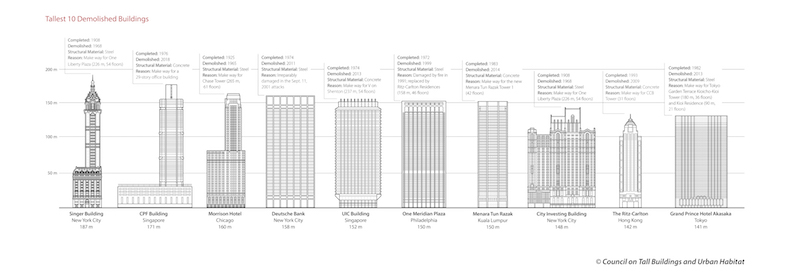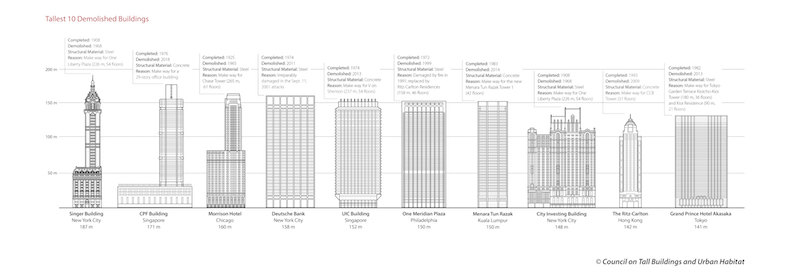What goes up, must come down. And, when it comes to tall buildings, often times the reason they come down is so a taller building can rise from the rubble, at least according to a new study from the Council on Tall Buildings and Urban Habitat (CTBUH). It is the concrete jungle’s version of the circle of life.
The recently released study, entitled Tallest Demolished Buildings, examines the 100 tallest buildings in history to have been dismantled by their owners, and some of the reasons for doing so.
The Singer Building in New York City is currently the tallest building ever conventionally demolished. The building stood 187 meters and 41 stories tall and was torn down in 1968 to make room for One Liberty Plaza. The 171-meter-tall CPF Building in Singapore and the 160-meter-tall Morrison Hotel in Chicago round out the top three.
Most of the world’s 100 tallest demolished buildings were torn down in order to build even taller high-rises. The average lifespan of the 100 tallest demolished buildings is only 41 years.
However, despite the possibility of the demolition of 270 Park Avenue in New York, which would become the first building over 200 meters to ever be conventionally demolished, you shouldn’t expect to see taller and taller buildings being demolished after just 41 years anytime soon.
Photo: Marshall Gerometta.
“There are currently more than 1,300 buildings of over 200 meters in height around the globe, and counting. Considering the tallest demolished building to date was only 187 meters tall, there’s really no precedent for tearing down 200- meter-plus towers, “said CTBUH Executive Director Antony Wood in a release. “We should perhaps thus be thinking of tall buildings as perpetual entities with lifecycles potentially exceeding 100 or 200 years, while designing them in such a way that they can be creatively adapted for potential future uses.”
The United States accounts for 53% of the world’s 100 tallest demolished buildings. More than a quarter of the 100 tallest demolished buildings were built between 1890 and 1920. High-rises built in the 1970s accounted for 24%.

Top 10 tallest conventionally demolished buildings:
Singer Building, New York City, 187 m
CPF Building, Singapore, 171 m
Morrison Hotel, Chicago, 160 m
Deutsche Bank, New York City, 158 m
UIC Building, Singapore, 152 m
One Meridian Plaza, Philadelphia, 150 m
Menara Tun Razak, Kuala Lumpur, 150 m
City Investing Building, New York City, 148 m
The Ritz-Carlton, Hong Kong, 142 m
Grand Prince Hotel Akasaka, Tokyo, 141 m
Related Stories
MFPRO+ New Projects | Oct 30, 2024
BIG’s One High Line finally reaches completion in New York City’s West Chelsea neighborhood
One High Line, a luxury residential project spanning a full city block in New York’s West Chelsea neighborhood, reached completion this summer following years of delays related to investor lawsuits.
Architects | Aug 28, 2024
KTGY acquires residential high-rise specialist GDA Architects
KTGY, an award-winning design firm focused on architecture, interior design, branded environments and urban design, announced that it has acquired GDA Architects, a Dallas-based architectural firm specializing in high rise residential, hospitality and industrial design.
Building Technology | Aug 23, 2024
Top-down construction: Streamlining the building process | BD+C
Learn why top-down construction is becoming popular again for urban projects and how it can benefit your construction process in this comprehensive blog.
Curtain Wall | Aug 15, 2024
7 steps to investigating curtain wall leaks
It is common for significant curtain wall leakage to involve multiple variables. Therefore, a comprehensive multi-faceted investigation is required to determine the origin of leakage, according to building enclosure consultants Richard Aeck and John A. Rudisill with Rimkus.
Adaptive Reuse | Aug 14, 2024
KPF unveils design for repositioning of Norman Foster’s 8 Canada Square tower in London
8 Canada Square, a Norman Foster-designed office building that’s currently the global headquarters of HSBC Holdings, will have large sections of its façade removed to create landscaped terraces. The project, designed by KPF, will be the world’s largest transformation of an office tower into a sustainable mixed-use building.
High-rise Construction | Jul 29, 2024
Safdie Architects’ Shanghai office tower features glass-enclosed corner garden that ascends the 35-story structure
Safdie Architects has announced the completion of LuOne Mixed-Use Complex—a business, retail, and entertainment development in the Luwan district of Shanghai, China. The mixed-use complex consists of an eight-level retail galleria, which opened in 2018, and a 35-story office tower, which recently reached completion.
Great Solutions | Jul 23, 2024
41 Great Solutions for architects, engineers, and contractors
AI ChatBots, ambient computing, floating MRIs, low-carbon cement, sunshine on demand, next-generation top-down construction. These and 35 other innovations make up our 2024 Great Solutions Report, which highlights fresh ideas and innovations from leading architecture, engineering, and construction firms.
Adaptive Reuse | Jun 13, 2024
4 ways to transform old buildings into modern assets
As cities grow, their office inventories remain largely stagnant. Yet despite changes to the market—including the impact of hybrid work—opportunities still exist. Enter: “Midlife Metamorphosis.”
Urban Planning | May 28, 2024
‘Flowing’ design emphasizes interaction at Bellevue, Wash., development
The three-tower 1,030,000-sf office and retail development designed by Graphite Design Group in collaboration with Compton Design Office for Vulcan Real Estate is attracting some of the world’s largest names in tech and hospitality.
Mixed-Use | Apr 4, 2024
Sustainable mixed-use districts: Crafting urban communities
As a part of the revitalization of a Seattle neighborhood, Graphite Design Group designed a sustainable mixed-use community that exemplifies resource conversation, transportation synergies, and long-term flexibility.

















